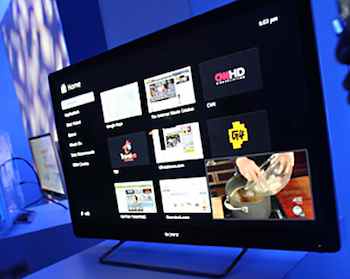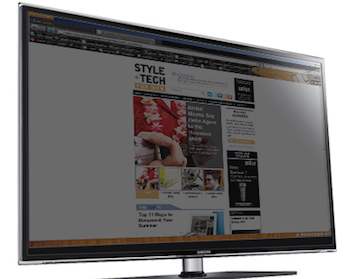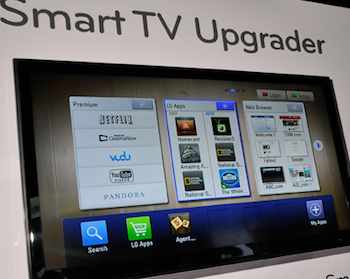- MENU
- HOME
- SEARCH
- WORLD
- MAIN
- AFRICA
- ASIA
- BALKANS
- EUROPE
- LATIN AMERICA
- MIDDLE EAST
- United Kingdom
- United States
- Argentina
- Australia
- Austria
- Benelux
- Brazil
- Canada
- China
- France
- Germany
- Greece
- Hungary
- India
- Indonesia
- Ireland
- Israel
- Italy
- Japan
- Korea
- Mexico
- New Zealand
- Pakistan
- Philippines
- Poland
- Russia
- South Africa
- Spain
- Taiwan
- Turkey
- USA
- BUSINESS
- WEALTH
- STOCKS
- TECH
- HEALTH
- LIFESTYLE
- ENTERTAINMENT
- SPORTS
- RSS
- iHaveNet.com
Tim Jarvis

Computers and televisions have finally gotten together, and their offspring is just taking their baby steps out into the market.
The big news at the Consumer Electronics Show (CES) in Las Vegas this year was Connected TV (aka Smart TV or Internet TV).
So what is it, and why should you care?
According to gadget guru Eric Schlissel -- owner and CEO of GeekTek.com, an IT services and tech-support company based in Los Angeles -- the next generation of TVs will offer the same functionality as the Roku player or Apple TV box, built into the television:
"With these TVs, you also get onscreen widgets, just like those on your PC or phone," says Schissel. "They can update the local weather, give you baseball scores or serve up the Euro/Dollar exchange rates," says Schlissel. "In some cases, the television will come with a built-in Web browser and a keyboard."
The good news is that the next TV you buy will probably already have a lot of these bells and whistles. "It's going to become standard, because the cost to the manufacturers is next to nothing to build these features in." The bad news is that you're going to be paying a premium for them.
If you head down to your local electronics store right now, the kid on the sales floor will be able to show you a bunch of Internet-connectable TVs with the usual major players standing out from the crowd. LG and Samsung are offering their own versions of Smart TV, and the Sony product has Google TV integrated directly into the unit.
To Buy or Not to Buy
At last year's CES, 3-D TV was the buzz phrase of Sin City. More than a year of hype and hundreds of headlines later, consumers are still not buying into it. So should you be one of the first to jump on the Connected TV bandwagon? How quickly will everybody else follow?
"The problem is that watching television is essentially a passive activity," says Schlissel. "I don't know how much people will really want to surf the Web on their TV, or deal with a keyboard." As he sees it, consumers aren't going to base their choice of TV on its ability to connect to the Internet, or on the platform or widgets it comes with. Their decision will largely be based on what it has always been based on: the quality of the picture.
So if you can wait for the dust to settle and the prices to come down, most Internet-enabled televisions are going to be offering the same smart features and similar content. And your choice will likely be shaped by variables that include picture quality, ease of setup and customer support.
Best of What's out There Now

Sony Internet TV
Sony Internet TV
Sony's Internet TV currently comes in four screen sizes that range from 24 to 46 inches. It's a fully functional HD-TV with Google TV built in, and it comes with a full QWERTY keypad remote.
According to Sony, you can surf the Web and enjoy both the Internet and television shows at the same time with inset screens.
You can also download thousands of applications from the Android Market.

LG Smart TV
LG Smart TV
LG is offering its Smart TVs with screen sizes from 32 to 55 inches, some of which come with 3-D capability.
Other features include full 1080p resolution, Web-browsing capabilities, a motion-sensitive remote control (for select models), a customizable dashboard, and the ability to download apps from the LG app store.
Plus, they're Wi-Fi-ready.

Samsung Smart TV
Samsung Smart TV
Samsung's Smart TVs are both 2-D and 3-D capable and come with screens ranging from 32 to 55 inches.
The company's Smart Hub interface connects you to proprietary Samsung apps, a search feature that allows you to find videos on your system, and recommendation functionality that auto-suggests movies you might enjoy through your on-demand services.
When Do You Need To Get Smart?
"I am a big fan of this technology," says Schlissel. "Everyone will eventually have access to it, but I'm not convinced they will care about it or make full use of all the features right now. At the moment, most of the content offered by the various manufacturers is basically the same. If you wait a bit, they will create new points of difference among themselves. Eventually, consumers will be swayed to a particular brand by good, original content that introduces them to the full range of what these televisions can do."
Photo Credits: Getty Images